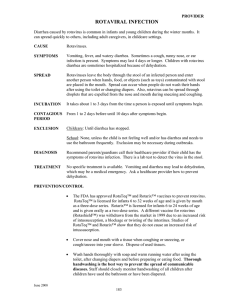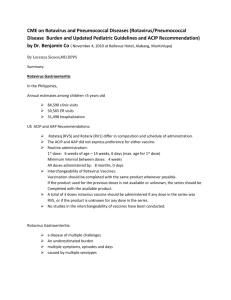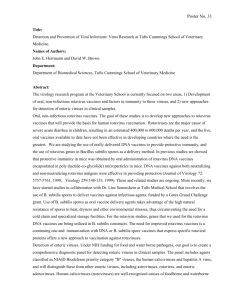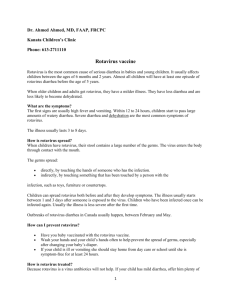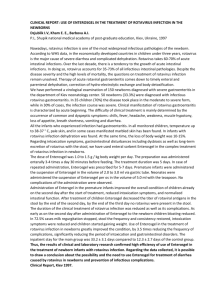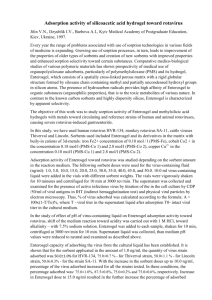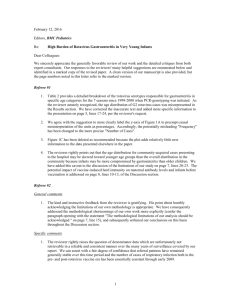Challenges of Rotavirus and Vaccines: Lessons for Global Health .
advertisement
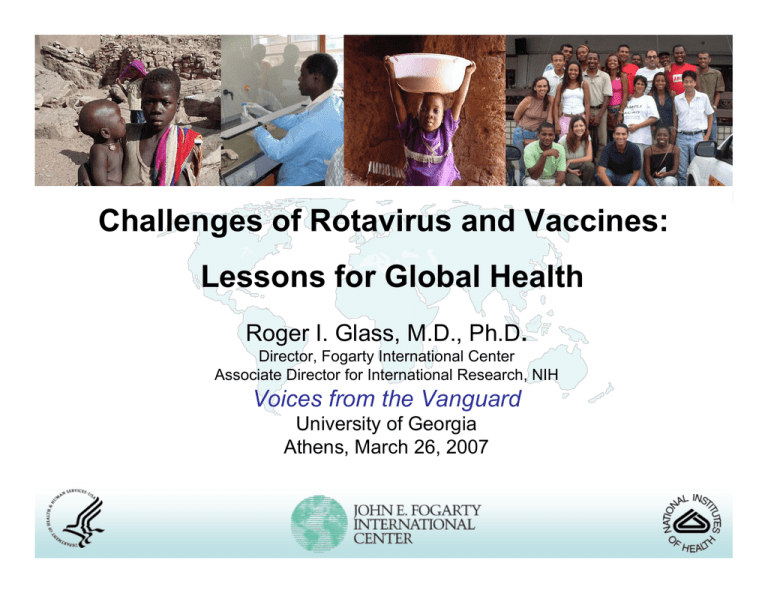
Challenges of Rotavirus and Vaccines: Lessons for Global Health Roger I. Glass, M.D., Ph.D. Director, Fogarty International Center Associate Director for International Research, NIH Voices from the Vanguard University of Georgia Athens, March 26, 2007 The Broad Street Pump - John Snow and the Transmission of cholera- 1854 1893 First cholera vaccines for control of an epidemic The water pump Revisited Bangladesh, 1980 Leading infectious causes of mortality, 2000 estimates 3.5 3.5 < 5 years old Deaths (millions) 3.0 2.7 2.5 2.0 1.7 1.5 1.1 > 5 years old Rotavirus causes 25%2.2 45% of diarrheal deaths 1.0 0.5 0 AIDS ARI Source: WHO TB Malaria Diarrhoea O. Levine Causes of severe acute gastroenteritis among children <5 years Developed Countries Unknown Rotavirus Bacterial Developing Countries Unknown Rotavirus Other Other Bacterial A. Kapikian Background on Rotavirus • Most common cause of severe diarrhea in children • All children infected by age 5 • “Democratic” virus • First infections symptomatic • Natural immunity • Limited strains in circulation • Improvements in sanitation won’t prevent infection The face of rotavirus Diarrhea Vomiting Dehydration Shock Death Tabasco, Mexico Jan 2005 Fatal Rotavirus Diarrhea Estimated global distribution of the 600,000 annual deaths caused by rotavirus 1 dot = 1000 deaths Parashar, 2005 RV Disease Burden- Developing Countries Risk 1 : 285 1 : 58 1:5 1:1 Events 600,000 deaths 2.3 million inpatient visits 24 million outpatient visits 114 million episodes 5% of all deaths in children < 5 1 in 285 children will die of RV Burden of Rotavirus in the US Risk 1 : 106 1 :80 1:7 1 : 0.9 Events 20-40 Deaths 60-70,000 Hospitalizations 500,000 Outpatient visits 3.2 Million episodes Cost: $400 M medical; >$1 B total Laboratory issues: Rotavirus Structure RNA Segment Protein 1 VP1 2 3 4 VP2 VP3 VP4 5 NSP1 6 VP6 7 8 NSP2 9 VP7 10 NSP4 11 NSP5 VP2 VP4 Neutralization antigen VP6 Subgroup antigen NSP3 VP7 Neutralization antigen Subcore and Evolution Summary of P & G Types of Rotavirus Childhood Diarrhea From 66 Published Studies (1993-2003) P[8]G1 52.2% P[8]G4 7.5% P[4]G2 11.5% P[8]G3 2.8% other 18.2% 5.5% N=21,256 Gentsch JID 2005 P[6]G9 P[8]G9 2.3% Rare or regionally common strains (23 strains total): P[4]G1 (1.3%), P[6]G2 (0.8%), P[6]G1 (0.6%), P[6]G8 (0.6%), P[4], G3 (0.5%) Recommended Childhood Immunization Schedule United States, January – December 1999 Age Vaccine Birth Hepatitis B Hep B 1 mo 2 mos 4 mos Hib Hib Polio IPV IPV Measles, Mumps, Rubella Varicella 15 mos Rv 18 mos 4-6 yrs Rv Hib 11-12 14-16 yrs Hep B DTaP DTaP DTaP H. influenzae type b Rotavirus 12 mos Hep B Hep B Diphtheria, Tetanus, Pertussis 6 mos DTaP DTaP Td Hib Polio Polio Rv MMR Var MMR MMR Var yrs Interval between Vaccine and Intussusception Murphy TV, et al, 2001 Studies of the Risk of Intussusception Following RotaShield® Study Author Risk Excess Cases for US Preliminary Data Livengood-NIP 1 in 2500 1600 Reassessment Livengood-NIP Case Series Murphy-NIP 1 in 4670 785 Case Control Murphy-NIP 1 in 9474 361 Cohort Study Kramarz-NIP 1 in 11,073 316 Ecologic Studies Chang-NYS <1 in 17 000 200 Simonsen-NIH all infants 45-210 days -11% 1 in 28,000 0 888 122 1 0.9 0.8 0.7 0.6 0.5 0.4 0.3 0.2 0.1 0 Immunization Schedules 50 US RATE 40 UK CASES 30 EPI 20 BCG 10 0 1 2 3 4 5 6 7 8 9 10 11 12 Months 80% of the IS were in the 50% of infants >90 days when vaccinated No Cases Cases/1,000 child-years Incidence Rates and Numbers of Hospitalized Cases of Intussusception by Age (months) VSD, 1991-1997 Let’s reassess the risks and benefits of RV vaccine Benefits 1 death in 250 children 600,000 deaths/ yr 25-50% of D admissions Risks 1 IS in 30,000 vaccinees ? 3500 severe IS cases The next generation of rotavirus vaccines Bovine rotavirus with single human rotavirus gene substitution Human rotavirus G1 G1P[8] GSK Bio Rotarix G3 P[8] G2 G4 Merck RotaTeq 2006 An Incredible Year for Rotavirus Volume 354 January 5, 2006 Number 1 Safety and Efficacy of a Pentavalent Human–Bovine (WC3) Reassortant Rotavirus Vaccine Timo Vesikari, M.D., David O. Matson, M.D., Ph.D., Penelope Dennehy, M.D., Pierre Van Damme, M.D., Ph.D., Mathuram Santosham, M.D., M.P.H., Zoe Rodriguez, M.D., Michael J. Dallas, Ph.D., Joseph F. Heyse, Ph.D., Michelle G. Goveia, M.D., M.P.H., Steven B. Black, M.D., Henry R. Shinefield, M.D., Celia D.C. Christie, M.D., M.P.H., Samuli Ylitalo, M.D., Robbin F. Itzler, Ph.D., Michele L. Coia, B.A., Matthew T. Onorato, B.S., Ben A. Adeyi, M.P.H., Gary S. Marshall, M.D., Leif Gothefors, M.D., Dirk Campens, M.D., Aino Karvonen, M.D., James P. Watt, M.D., M.P.H., Katherine L. O'Brien, M.D., M.P.H., Mark J. DiNubile, M.D., H Fred Clark, D.V.M., Ph.D., John W. Boslego, M.D., Paul A. Offit, M.D., Penny M. Heaton, M.D., for the Rotavirus Efficacy and Safety Trial (REST) Study Team Volume 354 January 5, 2006 Number 1 Safety and Efficacy of an Attenuated Vaccine against Severe Rotavirus Gastroenteritis Guillermo M. Ruiz-Palacios, M.D., Irene Pérez-Schael, M.Sc., F. Raúl Velázquez, M.D., Hector Abate, M.D., Thomas Breuer, M.D., SueAnn Costa Clemens, M.D., Brigitte Cheuvart, Ph.D., Felix Espinoza, M.D., Paul Gillard, M.D., Bruce L. Innis, M.D., Yolanda Cervantes, M.D., Alexandre C. Linhares, M.D., Pío López, M.D., Mercedes Macías-Parra, M.D., Eduardo Ortega-Barría, M.D., Vesta Richardson, M.D., Doris Maribel Rivera-Medina, M.D., Luis Rivera, M.D., Belén Salinas, M.D., Noris Pavía-Ruz, M.D., Jorge Salmerón, M.D., Ricardo Rüttimann, M.D., Juan Carlos Tinoco, M.D., Pilar Rubio, M.D., Ernesto Nuñez, M.D., M. Lourdes Guerrero, M.D., Juan Pablo Yarzábal, M.D., Silvia Damaso, M.Sc., Nadia Tornieporth, M.D., Xavier Sáez-Llorens, M.D., Rodrigo F. Vergara, M.D., Timo Vesikari, M.D., Alain Bouckenooghe, M.D., Ralf Clemens, M.D., Ph.D., Béatrice De Vos, M.D., Miguel O'Ryan, M.D., for the Human Rotavirus Vaccine Study Group Human-Bovine Reassortant Rotavirus Vaccine - RotaTeq® (Merck) • Pentavalent • Liquid vaccine with buffer, stabilizer • 3 doses, 2ml/dose, • easy to administer • Grows poorly -high dose (107-8), low shedding Clinical Trials of Rotateq Vac / Outcome Vac Placebo Placebo U.S., 2834/2839 Finland U.S. 650 /650 Efficacy (95%CI) Any Severe 83 / 315 1 / 51 74 (67-80) 98 (88-100) Any Mod/sev Severe 15 / 54 10 / 42 0/6 73 (51-86) 76 (52-89) 100 (13-100) From abstracts & presentations GSK Attenuated Human Rotavirus Vaccine, Rotarix® • Monovalent • Lyophilized vaccine, needs reconstitution • 2 doses, 1 ml/dose • Grows well -low dose (105.8); high shedding (>50%) Clinical Trials of Rotarix Vac/Placebo Outcome Finland, 245 / 123 464 / 454 Brazil, Mexico, Venezuela Latin 10,159 / 10,010 America Any Severe Vaccine Efficacy Placebo (95%CI) 13 / 23 72 (42-87) 2 / 10 85 (42-97) Any Severe. 15 / 49 5 / 3434 70 (46-84) 86 (63-96) Severe Hosp. NA 85 (72-92) 85 (77-94) From abstracts & presentations First rotavirus immunizations in Panama, Inaugurated by President Martin Torrijos and his wife, Viven de Torrijos March 14, 2006 Current status of licensure and introduction of Rotarix-GSK WHO Region Countries with licenses -Rotarix®(3/06) Americas 16 Argentina, Brazil, Chile, Colombia, Mexico, Africa Curaçao, Dom. Rep. , Ecuador, El Salvador, Guatemala, Jamaica Mexico, Peru, Panama, Suriname, Trinidad/Tobago, Venezuela 12 Cameroun, Cent.African Republic, Congo, DRCongo, Ghana, Guinea, Kenya, Malawi, Madagascar, Mali, Mali, Mauritius, Nigeria 1 Norway, EMEA Europe Middle East S.E. Asia West. Pacific 3 Bahrain, Kuwait, UAE 1 Thailand 3 Australia, Philippines, Singapore The biggest challenge for live oral rotavirus vaccines today is “ will they work for poor children in the developing world! To date, no live oral vaccine has been successfully tested for efficacy in a poor Country of Africa or Asia ! Preliminary data suggests that they Might not perform as well and we Will need to figure this out soon! Live oral vaccines –problems in the developing world • OPV Less immunogenic/more doses needed for children in India (T. Jacob Johns) • Cholera (Oralchol) Less immunogenic/higher titer needed in Thai/Indonesian studies ( Mike Levine) • Oral RV – RIT Failed in Africa/Peru – WC3 Failed in Africa – RRV Lower efficacy in Peru/Brazil – GSK Being tested in S.Africa/Bangladesh Rotavirus vaccines have a bad history for the poorest children in the developing world ! Timelines Where will new vaccines be made ? Germany R China India Indonesia/Aus Brazil 6 candidate vaccines 12 companies 5 countries Vietnam: Hospital Surveillance for Rotavirus, July 1998 - June 2000 Rotavirus Specimens screened N Sector/Cities North Hanoi Haiphong Rotavirus positives N % Hospitals National Children’s Hospital St. Paul’s Children’s Hospital Children’s Hospital South Khanh Hoa General Hospital Ho Chi Minh City General Pediatrics N. 1 General Pediatrics N. 2 Why are these rates so high ? 1233 390 886 657 185 531 53 47 60 589 1724 946 5768 348 982 544 3247 59 57 58 56 Van Mann, et all, JID, 2001 Rotavirus hospitalizations in the Asian Rotavirus Surveillance Network China: 41% Korea Taiwan: 41% Hong Kong: 29% Myanmar: 56% Vietnam: 60% Malaysia: 56% Indonesia: 39% Bresee 2003 EIDJ Rotavirus Surveillance networks EURO EMRO Asia PAHO AFRO Who is interested in supporting rotavirus vaccines today ? The International Finance Facility Conclusions “We are beginning a great experiment to see if we can control and perhaps eliminate rotavirus diarrhea through the use of vaccines” Creative Strategies for future funding Should we rename it “Rotaryvirus?” The Fogarty Mission • To address global health challenges through innovative and collaborative programs for research and training • To support and advance the NIH mission through global partnerships “Science for Global Health” Rhode Island Congressman John Edward Fogarty “… a man who, for more than a quarter of a century, worked tirelessly for a healthy America, in a healthier world.” Congressman Melvin Laird (R-WI) 1967 National Institutes of Health Office Officeof ofthe theDirector Director National NationalInstitute Institute on onAging Aging National NationalInstitute Institute on onAlcohol AlcoholAbuse Abuse and andAlcoholism Alcoholism National NationalInstitute Institute of ofAllergy Allergyand and Infectious InfectiousDiseases Diseases National NationalInstitute Institute of ofArthritis Arthritisand and Musculoskeletal Musculoskeletal and andSkin SkinDiseases Diseases National NationalCancer Cancer Institute Institute National NationalInstitute Institute Of OfChild ChildHealth Health&& Development Development National NationalInstitute Instituteon on Deafness Deafnessand andOther Other Communication Communication Disorders Disorders National NationalInstitute Institute of ofDental Dentaland and Craniofacial Craniofacial Research Research National NationalInstitute Institute of ofDiabetes Diabetesand and Digestive Digestiveand and Kidney KidneyDiseases Diseases National NationalInstitute Institute on onDrug DrugAbuse Abuse National NationalInstitute Institute of ofEnvironmental Environmental Health HealthSciences Sciences National NationalEye Eye Institute Institute National NationalInstitute Institute of ofGeneral General Medical MedicalSciences Sciences National NationalHeart, Heart, Lung, Lung,and andBlood Blood Institute Institute National NationalHuman Human Genome GenomeResearch Research Institute Institute National NationalInstitute Institute of ofMental MentalHealth Health National NationalInstitute Institute of ofNeurological Neurological Disorders Disordersand and Stroke Stroke National NationalInstitute Institute of ofNursing NursingResearch Research National NationalInstitute Instituteof of Biomedical BiomedicalImaging Imaging and andBioengineering Bioengineering National NationalCenter Center for forComplementary Complementary and andAlternative Alternative Medicine Medicine Fogarty Fogarty National NationalCenter Center For ForResearch Research Resources Resources National NationalLibrary Library of ofMedicine Medicine National NationalCenter Centeron on Minority Health Minority Healthand and Health HealthDisparities Disparities Clinical ClinicalCenter Center Center Centerfor for Information Information Technology Technology Center Centerfor for Scientific ScientificReview Review Fogarty International Center Major Research and Training Sites ¾60 US institutions >100 foreign institutions The Fogarty Portfolio – an Alphabet Soup 2006 $68 million > 400 grants Pedro Chequer, Director, National STD/AIDS Program, MOH, Brazil David Serwadda, Director, Institute of Public Health, Makarere University, Uganda Salim Abdool Karim, Director, CAPRISA S. Africa Jean Pape, Director, GHESKIO, Haiti Philippa Musoke, Chair of Pediatrics, Makarere University, Glenda Gray, Uganda Co-founder/Co-Director, Perinatal HIV Research Unit, Chris Hani Baragwanath Hospital, South Africa AITRP (Aids Intn’l Training & Research Program (1988-…) Investing in Leaders Marcos MarcosEspinal, Espinal,Stop Stop TB Partnership TB Partnership Secretariat, Secretariat,World World Health Organization Health Organization Zunyou ZunyouWu, Wu,Director, Director,National National Center for AIDS/STD Control Center for AIDS/STD Control&& Prevention, Prevention,Chinese ChineseCDC, CDC,China China Patricia PatriciaGarcia, Garcia,Chief, Chief, National Institute National InstituteofofHealth, Health, Peru Peru Ruth Nduati, Faculty of Medicine, College of Health Sciences, University of Nairobi America’s leaders in global health have early overseas training Al Sommer Hopkins Bangladesh Barry Bloom Harvard India Gerry Keusch BU/Thailand Bob Black Hopkins Bangladesh Palmer Beasley Taiwan Helene Gayle Care/Uganda Mike Merson Duke Bangladesh Bill Foege CDC Nigeria Alan Rosenfield Columbia Nigeria, Thailand Jeff Koplan CDC/ Emory Bangladesh Tom Quinn NIAID Zaire Dick Guerrant U. Va Brazil Fogarty Ellison Scholars 2006 24 “pairs” of trainees going to 16 medical centers in the developing world Framework Program 2005-2006 Russia China Mexico Peru Brazil Nigeria Tanzania Zimbabwe “Glues” multiple schools within a university or universities around the topic of global health ~19 US Programs Source: Fogarty International Center, Nov. 2006 The Uganda Cancer Institute, Mulago Hospital Denis Burkitt 1. Described “African Lymphoma” 2. Identified first viral cause of cancer (with Ebstein & Barr) 3. Described co-factors for cancer (immune suppression) 4. Identified first successful chemotherapy with anti-mitotic agents (with Burchenal, & Oettgen, Sloan Kettering) FI C Funding (NIH/ Other) Human and Institutional Capacity building Collaborative Long Term Relationships Investing in Global Health “Best Buys” and Priorities for Action in Developing Countries” Fogarty International Center, the World Bank, the World Health Organization, and the Population Reference Bureau, 2006 The Question: Can the world tackle its most challenging health problems? Changes in Life Expectancy in the past 500 years 3 62 10 Best Buys for Health 1. Prevent neonatal mortality 2. Ensure healthier mothers and children 3. Promote good nutrition 4. Reduce deaths from cardiovascular disease 5. Stop the AIDS pandemic 6. Stop the spread of tuberculosis 7. Control malaria 8. Combat tobacco Use 9. Reduce fatal and disabling injuries 10. Ensure equal access to high-quality health care *Items in red have an infectious basis 63 Website: DCP2.ORG Health Diplomacy Presidential Initiatives in Africa Presidents Emergency Program For Aids Research PEPFAR $15 B – 5 years Efforts to control avian flu and emerging infections Presidents Malaria Initiative - PMI $1.2 B – 5 years “Implementation Science” International Collaborations Professor M.K. Bhan, Secretary of the Department of Biotechnology negotiating agreements with NIH on HIV, child health, eye disease, Vaccines, emerging infections, biotechnology, …. Kaveh Khoshnood Arash Alaei Navid Madani New Advocates for Global Health Potential Partners for Global Health Universities, Medical Research Groups WHO World Bank Unicef Developing World Medical Research Councils U.S. Government Agencies FIC Private Sector Foundations e.g. Gates, Wellcome, etc NGOs NIAID, NICHD, NIMH, NIDCR, NCCAM “Now more than ever, an informed, proactive, and unified strategy will be key to advancing the science needed to improve the health of the world.” Source: Science 17 November 2006; Vol. 314, no. 5802, pp. 1088 - 1090 Bangladesh - 1980 <5 mortality > 120/1000 Family size - 6+ Family planning - unsuccessful Immunization coverage <5% Malnutrition – vit A, zinc, Iodine Causes of death – ARI/ Diarrhea Bangladesh- 2005 <5 mortality, 75/1000 Family size - 2.6 Women in workplace – garment industry Immunization coverage 75% Diarrheal deaths - decreased Causes of death – neonatal deaths 50%, arsenic, infections, smoking, accidents Summary Key concepts in our strategic plan Train the next generation of U.S. and foreign global health researchers (Early childhood education!) Build sustainable capacity for health science research, through institutional partnerships and research collaborations’ ( Build centers of excellence !) Advance implementation science as a tool for accelerating the application of research knowledge on a global scale. Building Sustainable Research Capacity Providing re-entry support for foreign scientists returning home Strengthen institutional capacity through twinning programs and research collaborations. Provide leadership for global health GLOBAL EXAMPLES OF EMERGING AND REEMERGING INFECTIOUS DISEASES (A.S. FAUCI) GLOBAL EXAMPLES OF GENETIC DISEASES AND DISORDERS GLOBAL EXAMPLES OF ENDURING ENVIRONMENTAL DISASTERS GLOBAL EXAMPLES OF PEDIATRIC AND ADULT CANCERS 1997 IOM Report “The United States is currently the global leader in biomedical research... The failure to engage in the fight to anticipate, prevent, and ameliorate global health problems would diminish America's stature in the realm of health and jeopardize our own health, economy, and national security” Has Global Health reached “the tipping point?” The tipping point is that magic moment when an idea, trend, or social behavior crosses a threshold, tips, and spreads like wildfire. Just as a single sick person can start an epidemic of the flu, so too can a small but precisely targeted push cause a fashion trend, the popularity of a new product, or a drop in the crime rate….. Some themes for Fogarty “Science anywhere helps people everywhere” “Take science where the problems are” Science for Global Health Thanks for the visit !
